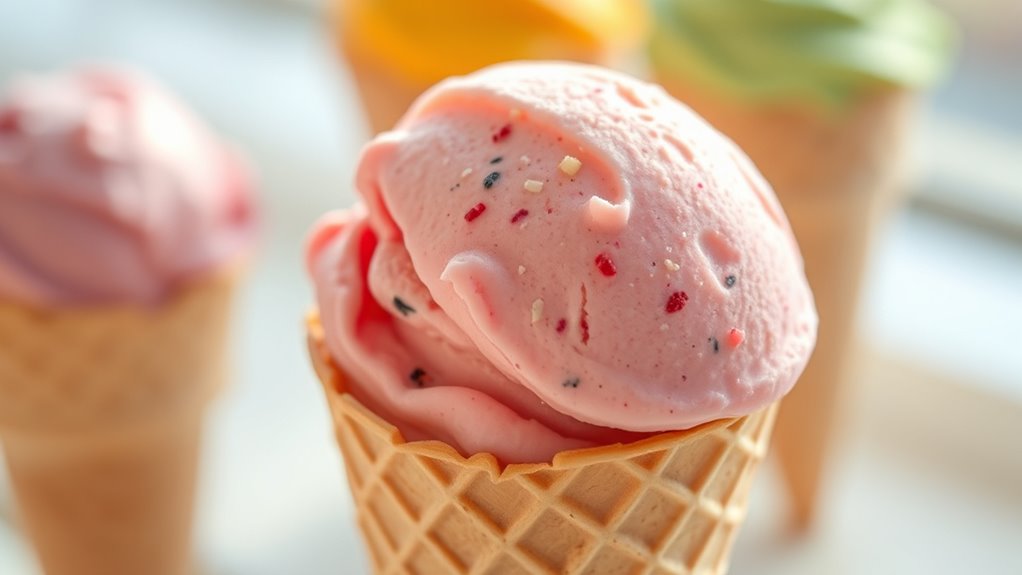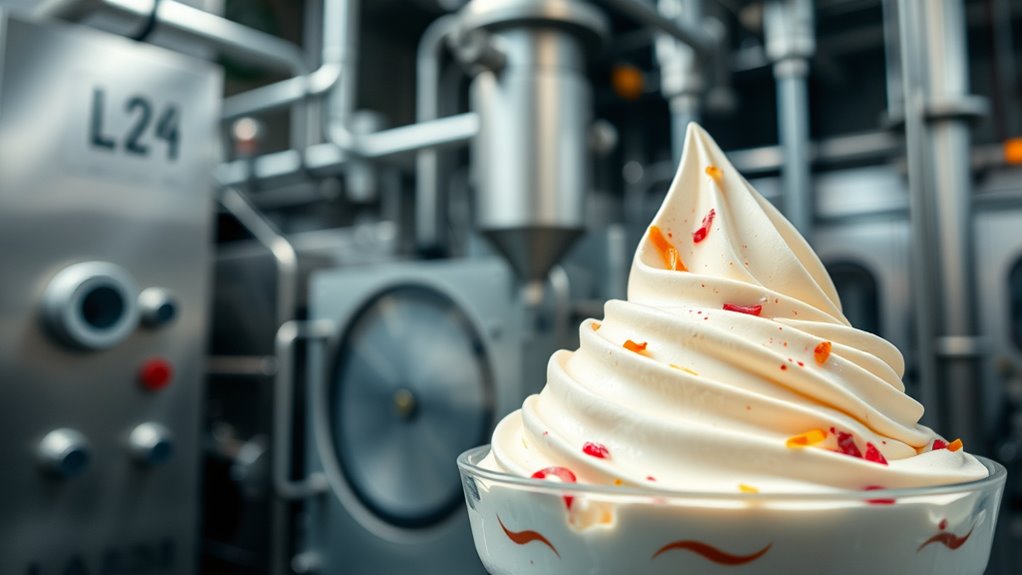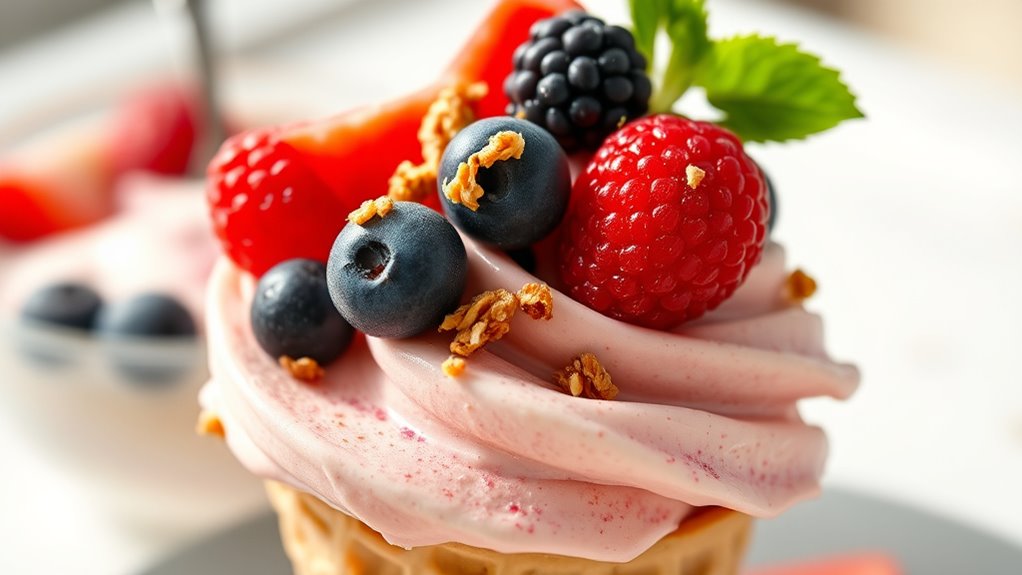Yes, some ice creams contain probiotics, especially those labeled as “probiotic ice cream.” These frozen treats mix live beneficial bacteria, like Lactobacillus and Bifidobacterium, with traditional ice cream. Though freezing can affect probiotic viability, manufacturers use protective measures to maintain their health benefits. Enjoying probiotic ice cream can support your gut health and overall wellness. Curious about the nutritional perks and market trends? There’s plenty more to explore on this tasty topic!
Key Takeaways
- Probiotic ice cream contains beneficial bacteria like *Lactobacillus acidophilus* and *Bifidobacterium bifidum*, promoting gut health and wellness.
- Freezing can reduce probiotic viability, but manufacturers use prebiotics to enhance survival during storage.
- Regular consumption of probiotic ice cream can support a balanced gut microbiome and boost the immune system.
- It often includes prebiotics like inulin, which nourishes probiotics and improves texture.
- Market demand for probiotic desserts is rising, reflecting increased consumer interest in health-oriented frozen treats.
Understanding Probiotic Ice Cream

When you think about ice cream, you mightn’t immediately consider its potential health benefits, but probiotic ice cream is changing that perception. This unique treat incorporates probiotic strains, such as Lactobacillus acidophilus and Bifidobacterium bifidum, into dairy or non-dairy bases. The formulation process involves mixing probiotic fermented milk with an ice cream mix, followed by freezing. However, challenges arise, as freezing temperatures can reduce the probiotics’ viability, impacting their health benefits. To tackle this, manufacturers carefully select strains and utilize prebiotics to protect them during freezing. Consumer education is essential to ensure that people recognize the health benefits of this innovative product. Sensory attributes like taste and texture also play a vital role in consumer acceptance. With the right formulation, probiotic ice cream can deliver deliciousness and gut-friendly benefits.
Nutritional Benefits of Probiotic Ice Cream

Probiotic ice cream offers a delightful way to combine indulgence with health benefits, making it a popular choice for those seeking nutritious treats. Packed with beneficial bacteria like *Lacticaseibacillus rhamnosus* and *Lactiplantibacillus plantarum*, this frozen delight supports gut health and may enhance your immune response. The antioxidant activity from fermented ingredients boosts its nutritional profile, while the protein and fat content remains comparable to traditional ice cream. With added vitamins and minerals, you’re getting more than just a sweet treat. Plus, ingredients like inulin act as prebiotics, nourishing the probiotics in your scoop. Furthermore, enjoying essential oils for respiratory health can complement the benefits of probiotic ice cream by promoting overall wellness. Additionally, the presence of soulmate angel numbers during significant life transitions can serve as a reminder to prioritize self-care, including gut health. Enjoying probiotic ice cream means satisfying your cravings while promoting digestive health and overall well-being. It’s a win-win for your taste buds and gut! Notably, frozen yogurt’s probiotic content may not survive the freezing process, making probiotic ice cream a more reliable source of gut-friendly bacteria. In fact, the U.S. is the largest consumer of ice cream worldwide, highlighting the popularity of this sweet treat among diverse populations. Furthermore, the rise of sustainable fashion trends suggests a growing interest in eco-friendly ingredients, which could influence future ice cream formulations.
Sensory Differences Compared to Traditional Ice Cream

While indulging in a scoop of ice cream, you might notice that probiotic varieties offer distinct sensory differences compared to their traditional counterparts. Probiotic ice cream often features unique flavor profiles and a slightly lower taste intensity. You may find the texture to be firmer due to added prebiotics like inulin, which also makes the ice cream appear more opaque. When enriched with fruit purees, the vibrant colors can enhance your overall experience. Notably, studies show that consumers generally accept these variations, as no significant off-flavors arise. While you enjoy that smooth mouthfeel and prolonged flavor, keep in mind that these sensory attributes play an essential role in how probiotic ice cream appeals to your taste buds. Additionally, probiotic bacteria showed high survival rates after production and during frozen storage, ensuring that the health benefits are maintained. It’s important to remember that moderation is key, especially since ice cream can be high in saturated fats. Furthermore, incorporating fiber-rich foods like chia seeds can help balance the indulgence and promote feelings of fullness. Interestingly, many fruit juices, like pomegranate juice, can also provide a delicious and nutritious complement to your dessert. Including whole foods in your diet can also enhance your overall health and wellness.
Technological Challenges in Production

The unique sensory attributes of probiotic ice cream come with a set of technological challenges that producers must navigate to guarantee quality and safety.
Adding fermented milks can raise the pH, altering the flavor profile. Probiotic cultures affect the mix’s specific gravity, impacting freezing points and overrun. To enhance the viability of probiotics, it is essential to add them before ripening, as this timing has been shown to significantly improve their stability. Additionally, achieving a creamy texture is crucial, similar to the creamy texture found in traditional ice cream recipes. Engaging in regular exercise can also be beneficial for maintaining the overall health of the probiotics. Furthermore, understanding the cultural significance of traditional foods can help producers create flavors that resonate with consumers. Utilizing performance cookies can assist in optimizing the website experience, ensuring users find relevant information easily.
You’ll need to maintain probiotic viability during freezing, as different strains like Lactobacillus and Bifidobacterium react differently to these conditions. Storage and handling techniques must prevent heat shock, ensuring consistent temperatures. Timing and method of probiotic incorporation also influence texture and sensory characteristics.
Finally, quality control measures are essential for meeting health standards and ensuring the product delivers on its health claims while maintaining consumer expectations.
Health Benefits of Regular Consumption

Regularly enjoying probiotic ice cream can provide a delicious way to support your gut health and overall wellness. The beneficial bacteria in probiotic ice cream aid digestion, helping to maintain a balanced gut microbiome. This tasty treat can also boost your immune system, reducing the risk of harmful pathogens. If you experience discomfort from lactose, certain lactose-free options can help alleviate symptoms like gas and bloating. Plus, the antioxidant properties from fermented ingredients enhance its health benefits. With essential nutrients like calcium and vitamins, probiotic ice cream supports your energy needs while promoting mental well-being. Additionally, it can help inhibit harmful pathogens such as C. diff, enhancing your overall health. Incorporating raw food into your diet can further improve digestive function and overall wellness. Moreover, regular consumption of probiotics can contribute to a balanced gut microbiome, which is essential for maintaining digestive health. Furthermore, understanding the concept of diversification in your diet can enhance your nutritional intake and support gut health through varied food sources. To maximize the benefits of your probiotic ice cream, consider pairing it with essential oils that promote digestive health, such as peppermint or chamomile.
Market Trends and Consumer Demand

As consumers increasingly prioritize health and wellness, the market for probiotic ice cream is experiencing a surge in demand. The probiotic desserts market was valued at $680.71 million in 2021 and is expected to reach $1.4 billion by 2031. This growth stems from a rising awareness of gut health benefits and the appeal of natural ingredients. With about 20% of consumers enthusiastic to try frozen treats with functional benefits, probiotic ice cream aligns perfectly with health-conscious diets. Notably, the interest in plant-based ingredients is driving innovation in probiotic ice cream formulations. Moreover, understanding legalities and zoning regulations for food products can help manufacturers navigate compliance in the growing market. Furthermore, the new Bitcoin holders trend indicates a broader shift in consumer behavior that favors health-oriented products. North America currently leads in market share, but the Asia-Pacific region is projected to grow the fastest. Consumers’ interests in online shopping further enhance market accessibility, making probiotic ice cream an attractive option for those seeking delicious, gut-friendly desserts. Additionally, the popularity of vegan diets contributes to the demand for plant-based probiotic options in frozen treats. Incorporating omega-3 fatty acids from ingredients like chia seeds can further enhance the health benefits of these frozen desserts.
Future Innovations in Probiotic Ice Cream

While many people enjoy ice cream for its indulgent taste, future innovations in probiotic ice cream promise to transform this beloved treat into a powerhouse of health benefits.
Advances in product development guarantee that probiotics like *Lactiplantibacillus plantarum* 299v survive during production, thanks to ice cream’s favorable pH. Incorporating prebiotics such as inulin not only boosts texture but also supports probiotic growth. Additionally, the rising demand for functional frozen treats is driving innovation in this sector, ensuring that consumers have access to healthier options. High-quality equipment for production processes is essential to maintain the integrity of these probiotics in the final product. Furthermore, the inclusion of dietary fiber in formulations can enhance gut health, complementing the probiotics.
Expect exciting collaborations, too, with companies like Ārepa and EatKinda creating specialized products targeting gut and brain health. Furthermore, sustainable ingredients and plant-based options, like those from Bifidice, enhance accessibility for consumers with dietary restrictions.
As research validates health claims, you’ll find probiotic ice cream evolving into a delicious, nutritious staple.
Frequently Asked Questions
Can Children Safely Consume Probiotic Ice Cream?
Yes, children can safely consume probiotic ice cream, but it’s important to keep a few things in mind.
Generally, probiotics are well-tolerated, and most kids won’t experience significant side effects. However, you should supervise their intake, ensuring it’s part of a balanced diet rather than a daily staple.
If your child has specific health conditions, consult a healthcare professional before introducing probiotics to their diet for added safety and guidance.
How Long Do Probiotics Last in Ice Cream?
Probiotics in ice cream can last several weeks, but their viability decreases over time, especially in frozen storage.
You’ll typically find that probiotic ice cream maintains a minimum viable cell count of (10^6 ) CFU/g for a good while.
To guarantee the probiotics stay alive, they should be added before ripening, and the product should be stored properly.
Is Probiotic Ice Cream Safe for Lactose-Intolerant Individuals?
Probiotic ice cream’s generally safe for lactose-intolerant individuals, especially if they can handle small amounts of lactose.
The high fat content in ice cream may actually help ease symptoms like bloating. Plus, many probiotic strains can assist with lactose digestion, reducing discomfort.
If you enjoy ice cream, opting for probiotic versions can be a tasty way to potentially improve your lactose tolerance without compromising on flavor or texture.
Just keep an eye on your individual tolerance levels!
Can I Make Probiotic Ice Cream at Home?
You can definitely make probiotic ice cream at home, blending health and indulgence.
Imagine enjoying a creamy, delicious treat while boosting your gut health! Start with cultured dairy like kefir or yogurt, mix in honey for sweetness, and add your favorite fruits or flavorings.
Whether you use an ice cream maker or a blender, the process is simple.
Once frozen, you’ll have a delightful dessert that’s not just tasty but also beneficial for your body!
Are There Flavors That Enhance Probiotic Effectiveness?
Yes, certain flavors can enhance the effectiveness of probiotics in your ice cream. Ingredients like fruit pulp or juice not only add taste but also contribute to the overall viability of the probiotic cultures.
You might find that flavors high in natural sugars, like berries, can improve firmness and texture while supporting probiotic growth. Incorporating prebiotics, such as inulin, can also optimize both flavor and probiotic effectiveness, making your treat even healthier.
Conclusion
To sum up, probiotic ice cream offers a delicious way to enjoy gut-friendly benefits without sacrificing taste. Imagine indulging in a creamy, chocolate-flavored treat that not only satisfies your sweet tooth but also boosts your digestive health. Brands like “GoodBelly” are already blending probiotics into their ice cream, proving that tasty options can exist side by side with wellness. As consumer demand grows, the future of probiotic ice cream looks promising, making it easier for you to enjoy healthier desserts.










